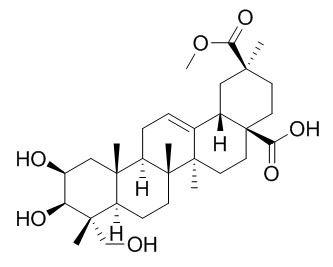Puncture wounds are caused by an object piercing the skin. Most puncture wounds will not bleed, but bacteria is introduced deep beneath the skin and into the body. Click here for more on deep puncture wounds.
 | |
American Sycamore
- Common Name: American Sycamore
- Scientific Name: Platanus occidentalis
- Family: Plantanaceae
- Habitat: Eastern Deciduous Forest
- Active Chemical Ingredients: Betulinic-acid
- Uses: Astringent, antiseptic
- Preparation: Wash made from inner-bark
Treatment:
American Pokeweed
- Common Name: American Pokeweed
- Scientific Name:Phytolacca americana
- Family: Phytolaccaceae
- Habitat: Eastern Deciduous Forest/Tall Grass Prairie
- Active Chemical Ingredients: Phytolaccagenin
- Uses: anti-inflammatory, cleanses the blood, analgesic
- Preparation: Eat the boiled berries, CAUTION! If eaten raw, they are poisonous!!!
 |
| phtyolaccagenin |
- Web. 7 Sept. 2015. http://images.ddccdn.com/cg/images/en3066761.jpg.
- "Cuts, Scrapes and Puncture Wounds Symptoms, Causes, Treatment - How Are Puncture Wounds Different? - MedicineNet." MedicineNet. Web. 7 Sept. 2015.
- (n.d.). Retrieved September 8, 2015, from http://wildflowerfinder.org.uk/Flowers/S/Spurge(Sea)/BetulinicAcid.png
- Platanus occidentalis - Natural medicine facts. (n.d.). Retrieved September 8, 2015.
- Practical Plants. (n.d.). Retrieved September 8, 2015.
- (n.d.). Retrieved September 8, 2015, from http://www.giftpflanzen.com/Copyright_giftpflanzen.com/phytolaccagenin.gif
- Pokeweed. (n.d.). Retrieved September 8, 2015, from http://altnature.com/gallery/pokeweed.htm
- Pokeweed. (n.d.). Retrieved September 8, 2015, from http://www.naturalremedies.org/pokeweed/
- Pokeweed Uses, Benefits & Dosage - Drugs.com Herbal Database. (n.d.). Retrieved September 8, 2015.
- Pokeweed, American (Phytolacca americana): The Jekyll and Hyde Plant. (n.d.). Retrieved September 8, 2015.
- WW Misc. (n.d.). Retrieved September 8, 2015, from http://www.catnapin.com/WildFlowers/Flowers-W/wwMisc.htm


/BetulinicAcid.png)

No comments:
Post a Comment